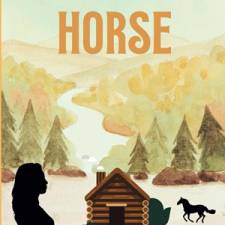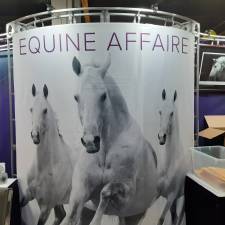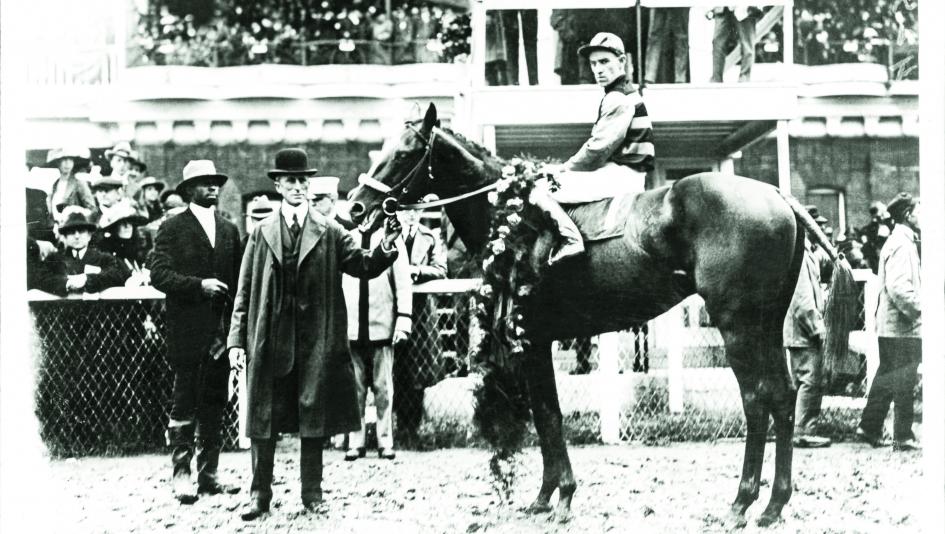
by Terry Conway
John E. Madden was the consummate horseman. He bred champions. He broke, trained and raced many of the good ones himself. The shrewdest horse trader of his era, he cashed them in too.
In the early decades of the 20th century his Hamburg Place Farm in Lexington, Ky., was the celebrated birthplace of Kentucky Derby winners Old Rosebud, Paul Jones, Zev, and Flying Ebony.
SIR BARTON Foaled: Spring 1916 Died: Oct. 30, 1937 Sire: Star Shoot Dam: Lady Sterling, by Hanover Breeder: John Madden (Ky.) Birthplace: Hamburg Place Farm
Hopes were high at Madden's showplace breeding center for greater glory in 1916 when a compact chestnut colt with a crooked blaze was foaled. The colt was given the regal-sounding name Sir Barton. His grandsire, Isinglass, had been crowned England's sixth Triple Crown winner in 1893. Isinglass' son Star Shoot was brought in 1912 to the United States, where he topped the American sire list five times.
As a 2-year-old, Sir Barton's lofty pedigree proved to be a bust. He raced four times for Madden, finishing out of the money each time. Plagued by tender hooves, a trait he inherited from his sire, the malady gave him a particularly nasty disposition. Grouchy and stubborn, Sir Barton had little time for people, horses, and other animals with one exception — his groom, Toots Thompson.
In the summer of 1918, J. K. L . Ross was prowling Hamburg Place, looking for game. Madden was looking to deal.
For $10,000, a goodly sum at the time, Ross bought Sir Barton. An heir to a tremendous railroad fortune and Canadian war hero, Ross won the Preakness with Damrosch in 1916. His powerful stable dominated the sport in 1918 and 1919 with stars such as Billy Kelly, Boniface, Constancy, Milkmaid, Cudgel, and Hallucination.
Still, it was Sir Barton who brought Ross the greatest fame. In 1919, Sir Barton emerged to sweep the Kentucky Derby, the Preakness Stakes, and the Belmont Stakes. It was a feat that 11 years later would be tagged the “Triple Crown”, the sport's holy grail.
Ross handed the colt over to H. Guy Bedwell who had worked as a cowboy in Colorado before moving east to train Thoroughbreds. His first priority was to address the colt's soft, shelly hooves. The trainer instructed a blacksmith to insert a strip of piano felt between Sir Barton's shoes and hooves to cushion pounding on the track. The colt detested workouts, so much so he would extend himself only when pushed by other horses. Bedwell set up relays of horses to chase him around the track in the morning.
“To get him fit you have to half kill him with work - and a lot of other horses as well,” Bedwell explained.
Sir Barton was trounced in his first outing, the Hopeful Stakes in Saratoga, but sprang to life to finish a good second in the Belmont Futurity to close out his 2-year old campaign.
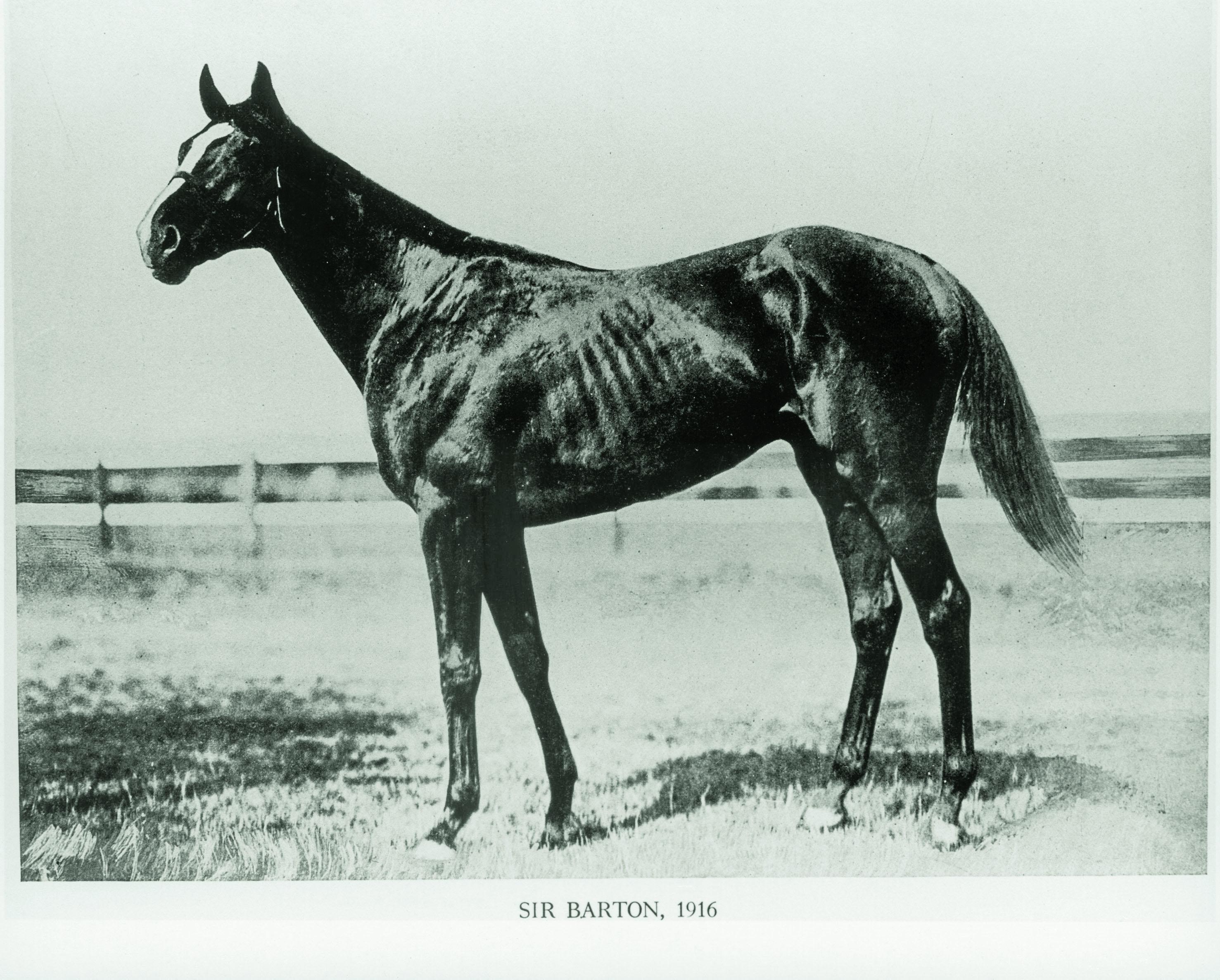
Sir Barton made his 3-year-old debut in the 44th edition of the Kentucky Derby. Bedwell's plan was simple: The colt would serve as a rabbit to wear down the speedy favorite, Eternal, so that highly fancied stablemate Billy Kelly could storm home the winner.
On May 10, 1919, the Churchill Downs dirt track was listed as "heavy" from a night of rain. With Johnny Loftus in the irons, Sir Barton grabbed a two-length lead early then opened up in the stretch and crossed the finish line with his ears pricked, a five-length winner. Billy Kelly was the runner-up, Eternal faded to 10th.
Sir Barton was shipped to Baltimore by train for the Preakness four days later. On a fast track, he whipped Eternal by four lengths. Ross’ colt kept his peak form 10 days later when he came from behind to knock off Eternal in the Withers at Exterminator in Saratoga track record time of 2:01 4/5.
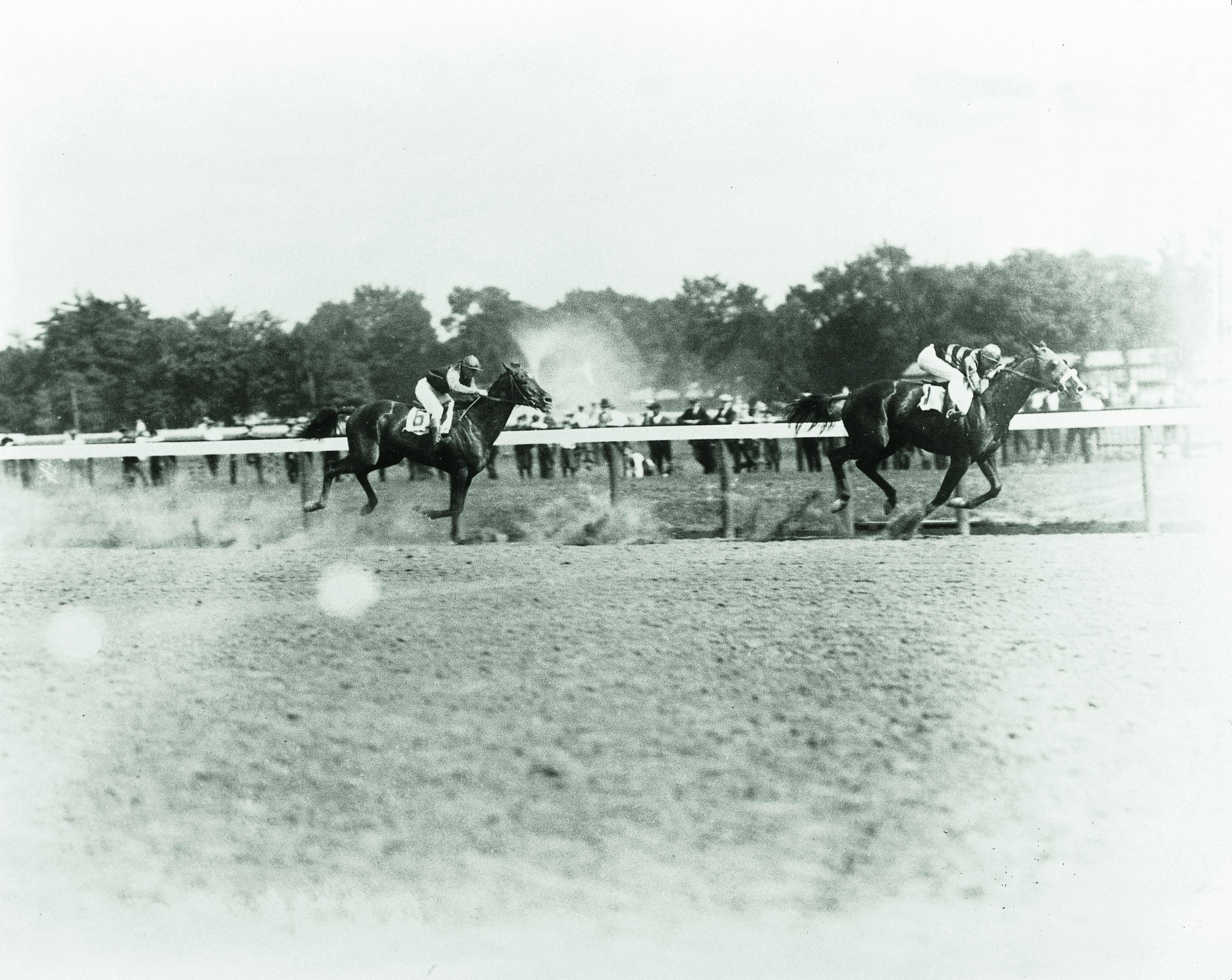
Still, Sir Barton had the misfortune of racing in the massive shadow of Man o' War. On October 12, 1920, the two squared off in Canada for a much-hyped match race. Sir Barton's feet appeared to be bothering him again as he stepped onto the hard Kenilworth Park surface. Man o' War pounded out a seven-length victory in track-record time. When Sir Barton hit the wire he had lost all four of his shoes.
The colt raced an additional three times that year but never won again. Ross sold him and he was sent to stud, standing for 11 years in Virginia and then Kentucky without much success. He was quickly forgotten by the racing world.
At this point, Sir Barton's story goes off the rails. He spent his later years as a working horse at the U.S. Army Remount Station in Nebraska, the Army's division in charge of breeding and supplying military horses. His stud fee plummeted to a paltry $5 to $10. In 1933, he was sold to a Wyoming doctor by the name of J.R. Hylton who allowed the old champion to live out his days on his ranch. In 1937, Sir Barton died of colic and was buried near his paddock.
Sir Barton would not be officially recognized as a Triple Crown winner until 1947, after six other racehorses were granted the title. In 1968, he was reburied at Washington Park in Douglas, Wyo. The final irony of his remarkable life: Sir Barton is memorialized by a fiberglass horse statue bearing no resemblance to racing's first Triple Crown champion.
Fun Facts
- Sir Barton's four major stakes wins in 1919 were accomplished in a space of just 32 days.
- Man o’ War was known as “Big Red” and Exterminator answered to “Old Bones.” Yet perhaps as a result of his irascible temperament, Sir Barton was denied the honor of a nickname.
- Author Marvin Drager later attempted to correct the slight, dubbing him “The Tender-Toed Typhoon.”
- Having a bad case of nerves before the Man o’ War match race, Sir Barton's jockey Earle Sande was replaced by Frank Keogh.
- Prior to the 1919 Kentucky Derby, Ross made a $50,000 side bet in a New York restaurant that Billy Kelly would finish ahead of Eternal. The man on the other side of the wager was mobster Arnold Rothstein. Later that year, he tried to bribe the Chicago White Sox and rig the World Series.
- If Ross doesn't make the bet, he never tells Sir Barton's jockey to rocket out of the gate and the horse doesn't win the Derby, and the entire course of American horse racing is changed.
- Elected into the Hall of Fame in 1957, Sir Barton is ranked No. 49 on Blood-Horse magazine’s Top 100 Racehorses of the 20th Century. Man o’ War is No. 1.
This article originally appeared on America's Best Racing and is published here with permission.
Read other interesting stories in our section on Recreation & Lifestyle.









